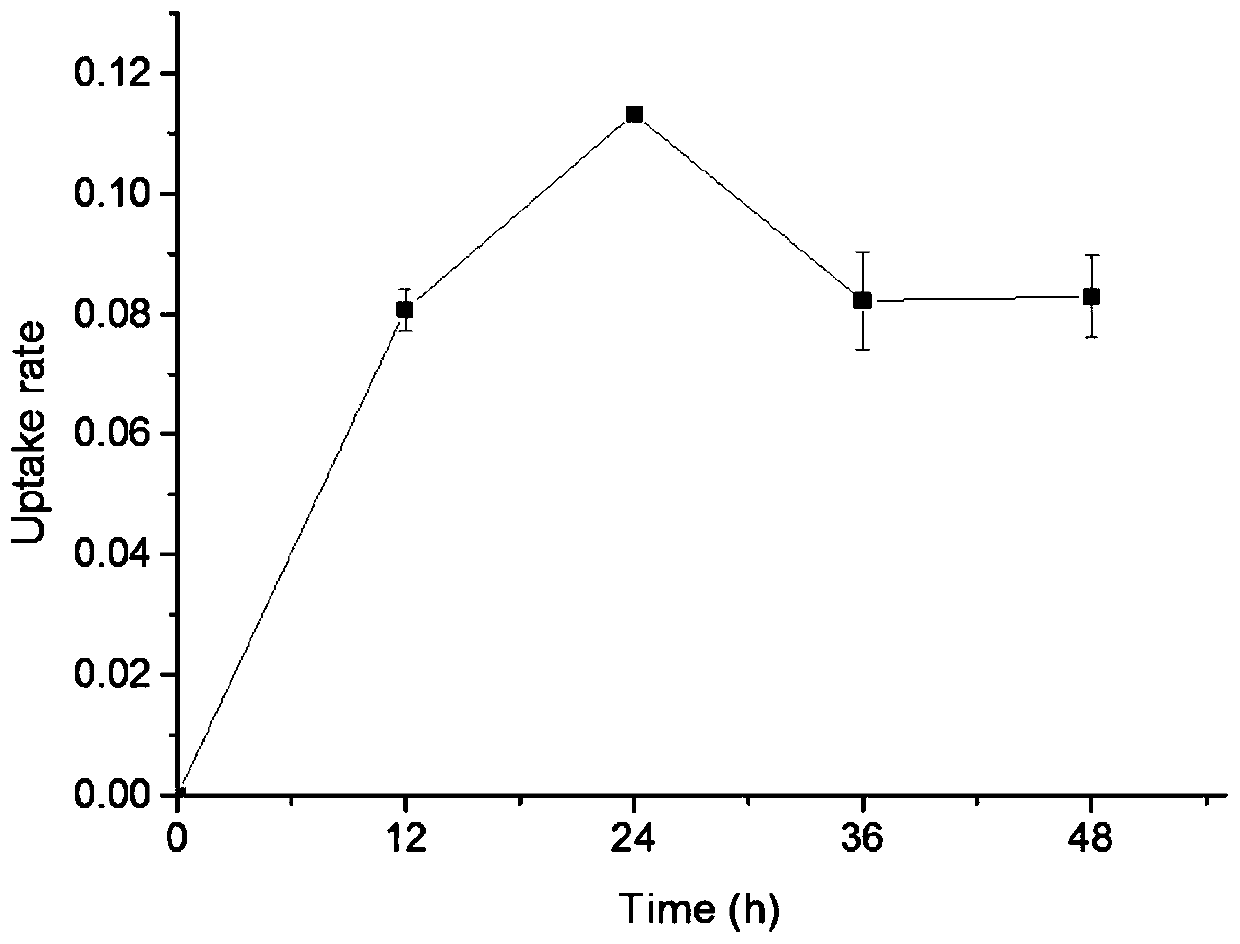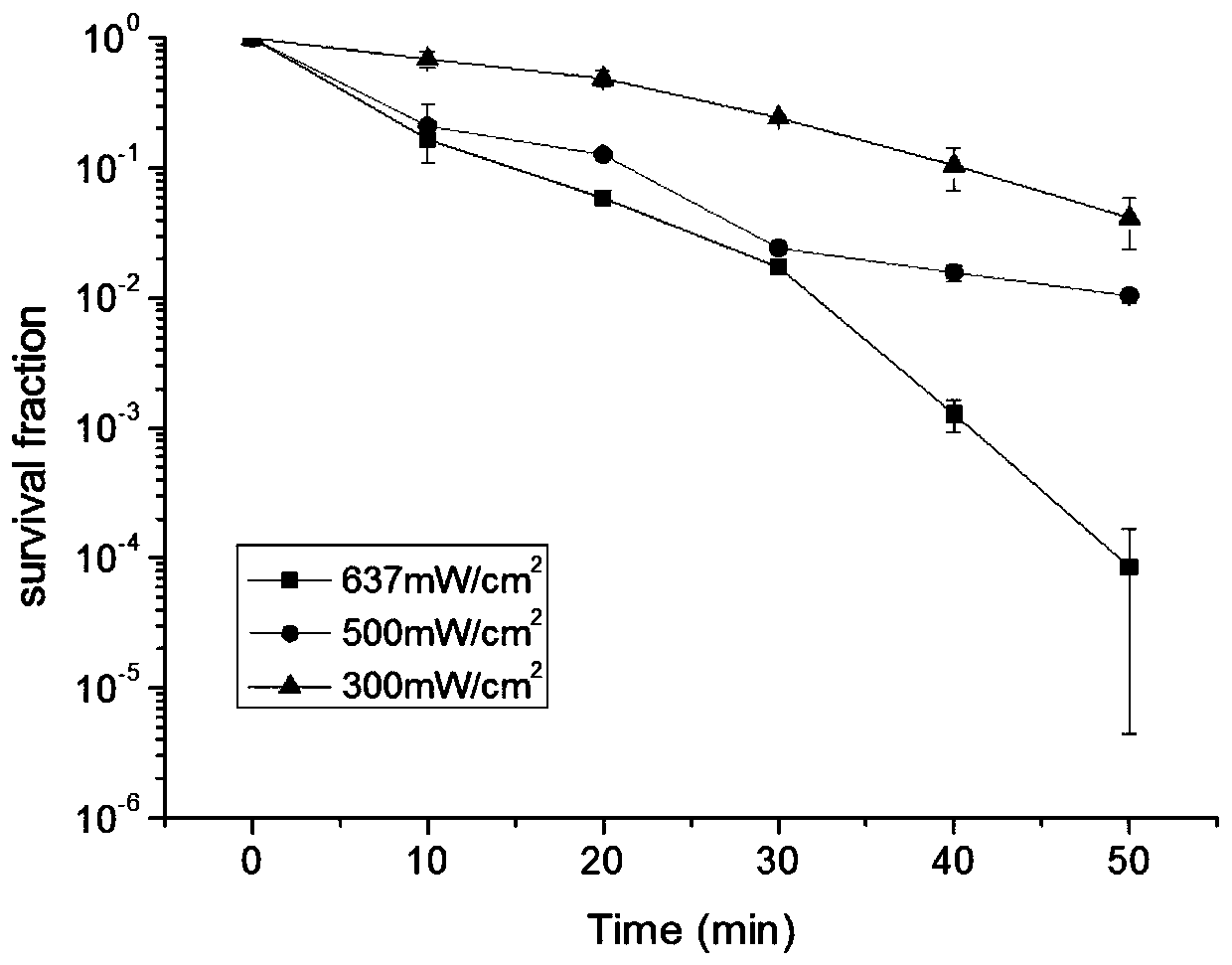Positively charged water-soluble arm-type dendritic ligand silicon phthalocyanine complex and its preparation method and application
A positively charged, water-soluble technology, used in organic silicon compounds, pharmaceutical formulations, chemical instruments and methods, etc., can solve the problem of shortening the quantum yield and lifetime of singlet and triplet states, easy aggregation, and reducing the fluorescence quantum of phthalocyanine molecules. Yield and other issues, to achieve the effect of improving bioavailability and water solubility
- Summary
- Abstract
- Description
- Claims
- Application Information
AI Technical Summary
Problems solved by technology
Method used
Image
Examples
specific Embodiment 1
[0035] 1) Dichlorosilicon phthalocyanine (SiPcCl 2 )Synthesis
[0036] Add 1,3-diiminoisoindoline (7.28 g, 50.15 mmol), silicon tetrachloride (8.3 mL) and quinoline (83 mL) respectively into a three-necked flask, stir and reflux for 30 min at 220 °C , cooled to room temperature, poured it into 500mL methanol solution, stirred and stood for about 1h, filtered, and washed the filter residue with 35 mL each of acetone, methanol, dichloromethane, methanol and other solvents, and dried to obtain 3.6759 g of a purple solid. The yield was 48.62%.
[0037] ) Synthesis of 3,5-bis(bromopropoxy)benzyl alcohol (abbreviated as M1 in the present invention)
[0038] Add 3,5-dihydroxybenzyl alcohol (1.4018 g, 10 mmol) into a 250 mL three-necked flask, add 52 mL of acetone solvent to dissolve it, add 1,3-dibromopropane (12.3683 g, 60 mmol), anhydrous K 2 CO 3 (8.2887 g, 60 mmol), 18-crown-6 (0.5244 g, 2 mmol). in N 2 Under protection, the reaction was stirred at reflux for more than 4h. ...
Embodiment 1
[0059] In Example 1, in process 2), 3,5-dihydroxybenzyl alcohol was changed to 2.10 g, 1,3-dibromopropane was 18.2683 g, other reaction conditions were the same, and the yield was 42.60%.
[0060] In process 3), 3,5-dihydroxybenzyl alcohol was changed to 2.10 g, 1,4-dibromobutane was changed to 19.1 g, the other reaction conditions were the same, and the yield was 40.62%.
[0061] In process 4), 3,5-bis(bromopropoxy)benzyl alcohol was changed to 1.60 g, 3-methylpyridine was changed to 2.94 g, and the other reaction conditions were the same, and the yield was 67.24%.
[0062] In process 5), 3,5-bis(bromobutoxy)benzyl alcohol was changed to 1.90 g, isoquinoline was changed to 6.78 g, the reaction temperature was changed to 70°C, and other reaction conditions were the same, yield: 57.1%.
[0063] In process 6), 3,5-bis(bromopropoxy)benzyl alcohol was changed to 0.78 g, and dichlorosilicon phthalocyanine was changed to 0.30 g. Other reaction conditions were the same, and the yield...
specific Embodiment 3
[0068] In embodiment one,
[0069] In process 2), 3,5-dihydroxybenzyl alcohol was changed to 4.20 g, 1,3-dibromopropane was 21.60 g, and the yield was 45.30%.
[0070] In process 3), 3,5-dihydroxybenzyl alcohol was changed to 4.50 g, 1,4-dibromobutane was changed to 26.2 g, and the yield was 39.42%.
[0071] In process 4), 3,5-bis(bromopropoxy)benzyl alcohol was changed to 3.20 g, 3-picoline was changed to 2.94 g, and the yield was 59.78%.
[0072] In process 5), 3,5-bis(bromobutoxy)benzyl alcohol was changed to 1.90 g, isoquinoline was changed to 5.23, the reaction temperature was changed to 70°C, and the yield was 57.1%.
[0073] In process 6), 3,5-bis(bromopropoxy)benzyl alcohol was changed to 0.78 g, dichlorosilicon phthalocyanine was changed to 0.30 g, the reaction temperature was changed to 80°C, and the yield was 19.2%.
[0074] In process 7), 3,5-bis(bromobutoxy)benzyl alcohol was changed to 0.10 g, dichlorosilicon phthalocyanine was changed to 0.42 g, the reaction t...
PUM
 Login to View More
Login to View More Abstract
Description
Claims
Application Information
 Login to View More
Login to View More - R&D
- Intellectual Property
- Life Sciences
- Materials
- Tech Scout
- Unparalleled Data Quality
- Higher Quality Content
- 60% Fewer Hallucinations
Browse by: Latest US Patents, China's latest patents, Technical Efficacy Thesaurus, Application Domain, Technology Topic, Popular Technical Reports.
© 2025 PatSnap. All rights reserved.Legal|Privacy policy|Modern Slavery Act Transparency Statement|Sitemap|About US| Contact US: help@patsnap.com



